A resistant variety for harsh weather conditions - the famous tomato “Pride of Siberia”
Thanks to the continuous work of Russian breeders, the cultivation of tomato crops has become accessible in regions with difficult climates. Residents of the northern regions do not have such a large choice, which is why it is so important for them to create new species that can take root in harsh conditions and bear fruit.
The Pride of Siberia tomato has won universal recognition due to its excellent taste and large fruit size. Simple agricultural technology determined the final choice of many gardeners. Those who have planted tomatoes in their greenhouses completely agree with its name and speak of it with admiration.
Characteristics of the variety
The Pride of Siberia tomato belongs to large-fruited varieties intended for cultivation in protected structures. Nevertheless, the culture takes root well in open beds in regions with a temperate climate.
Distinctive features
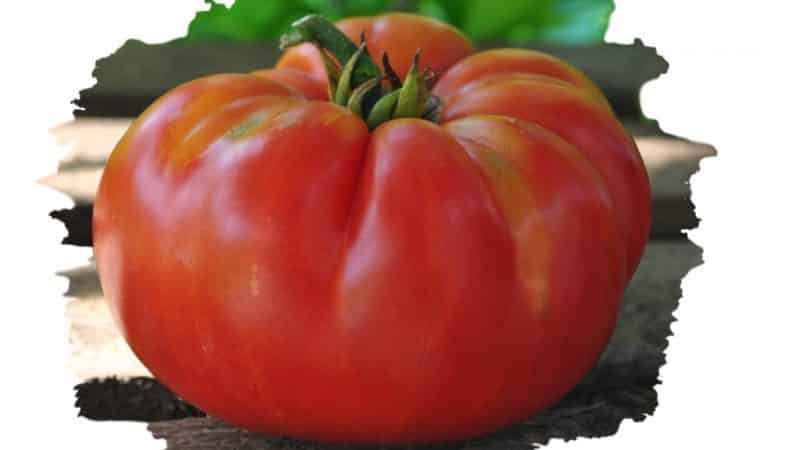
The height of the bush is up to 1.5 m. The type is determinant, standard. The stem is powerful, the foliage is moderate. The culture is resistant not only to diseases of various etiologies (late blight, tobacco mosaic virus, brown spot, blossom end rot), but also to temperature changes and lack of sunlight.
The ripening period is early, from the moment of sowing the seeds to full ripening, 85–90 days pass.
The productivity is high: up to 20 kg of fruits are collected from 1 m2, provided that 4-5 plants are planted per 1 m2.
Culture requires mandatory garters and regular stepsons due to the heaviness of ripe fruits and the large number of side shoots.
Fruit characteristics
Average weight is 600–700 g, the shape resembles a small pumpkin, the color is rich, raspberry-red. The taste is excellent, sweetness is harmoniously combined with light sourness, the flesh is juicy. The peel is quite durable, so ripe vegetables can be stored for a long time and transported over long distances.
Reference! Of all the varieties intended for the northern regions, the Pride of Siberia tomato fruits are the largest.
Due to their large size, it will not be possible to pickle and preserve whole vegetables. Otherwise, ripe tomatoes have no equal. They serve as a decoration for any salad, side dish and vegetable dish. In addition, they are processed into excellent juices, pastes, adjika, ketchups, lecho and sauces.
The photo shows Pride of Siberia tomatoes.
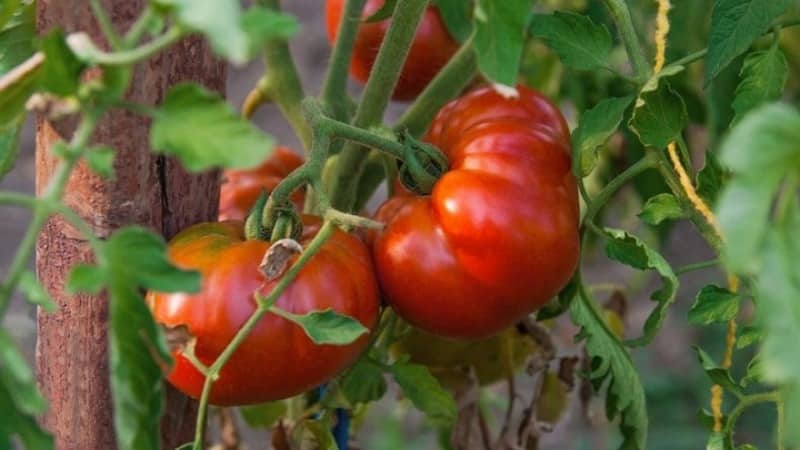
How to grow seedlings
The gardener can collect the seeds for planting tomatoes himself. Before planting, the seed needs to be prepared.
Seed preparation
It takes place in three stages:
- Rejection of seed material. This is done through a thorough inspection for visible damage.
- Definition of emptiness. Prepare a saline solution (1 teaspoon of salt per 1 cup of water) and place the grains in it for 10 minutes. The seeds that float to the surface are disposed of.
- Disinfection in a weak solution of potassium permanganate: The seeds are kept in the mixture for 20 minutes, then washed with running water and dried. To obtain the desired solution, 1 g of manganese is dissolved in 1/2 tbsp. water.
To improve germination, seed material is germinated on damp gauze for 2-3 days until sprouts appear. The gauze moistened with warm water is left in a dark place at a temperature of +28 °C.
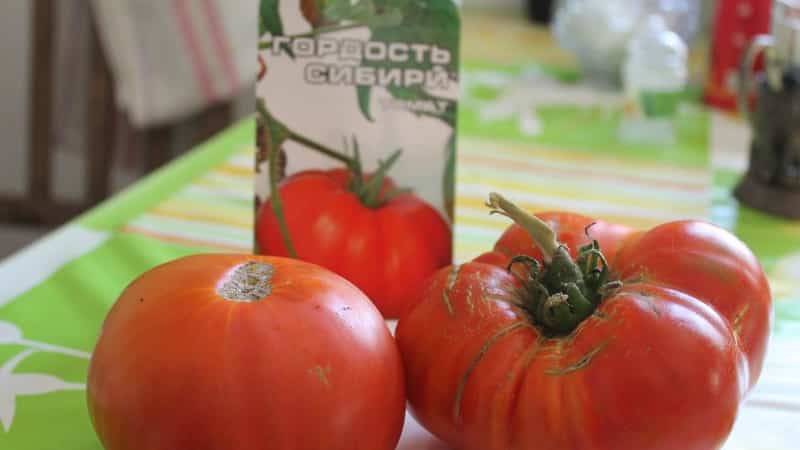
Container and soil
The soil is prepared from garden soil, humus and peat in equal quantities. Washed river sand is added as a leavening agent. For nutritional value, the soil is supplied with a small amount of superphosphate. The resulting mixture is poured with a hot solution of dark manganese. Soil disinfection is necessary for healthy seedling growth. Manganese solution can be replaced with copper sulfate.
Reference! Copper sulfate destroys fungal spores that are dangerous to tomatoes.
You can plant them in a common wooden box or in separate containers. The main thing is to make drainage holes at the bottom of each container, where excess moisture will drain. In their absence, excess fluid can provoke the occurrence of a dangerous disease - blackleg.
Reference! Blackleg destroys up to 90% of all plantings. This is a fungal disease characterized by blackening of the stem near the root.
Sowing
For sowing seeds, make grooves 1 cm deep. The distance between them is left 3 cm. After planting, the soil is slightly compacted and watered with warm, settled water from a spray bottle. The sown containers are left in a bright and warm room at a temperature of +22 °C until germination.
Seedling care

As soon as the first shoots appear, the containers are moved to a more illuminated place on the windowsill. Daylight is necessary for the full development of seedlings. If there is a lack of sunlight, they will stretch out and weaken. Therefore, you should take care of additional lighting in advance, especially in cold regions.
Water the seedlings as the top layer of soil dries out with warm, settled water from a shallow watering can. After moistening, the soil is loosened.
When 2 true leaves appear, the seedlings are picked and planted in separate containers.During picking, the main root is shortened by one third. This promotes the growth of lateral roots, due to which the seedlings develop more intensively.
After picking the seedlings feed complete complex fertilizer. Fertilizing is combined with watering.
Young plants are hardened 2-3 weeks before transplantation. This procedure is necessary for better adaptation to new conditions. First, the seedlings are taken out into the open air for 1 hour during the day, then the time is gradually increased to 10 hours.
How to grow tomatoes
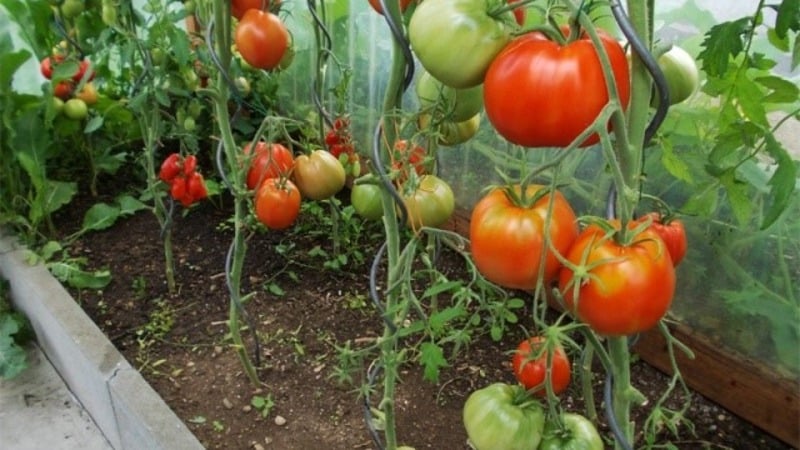
After the soil warms up to 15 °C, the seedlings are transplanted into the ground. By this time, the bushes have 5–7 true leaves. The soil for planting is prepared in advance: it is dug up and mineral fertilizers are applied.
Landing
No more than 5 seedlings are placed per 1 m2 in a checkerboard pattern. This method of arrangement helps each bush to receive a sufficient amount of sunlight and does not interfere with ventilation.
The holes are made no deeper than 20 cm and filled with warm water. After transplantation, the soil is moistened again and left to adapt for 2 weeks.
Reference! While getting used to a new place, seedlings are not watered, as they are not able to absorb moisture. All the forces of plants go into adaptation.
Further care for tomato
Regular watering is established as rooting occurs in a permanent place. Moisten the soil abundantly and often, but only with warm, settled water. Seedlings should not be flooded, otherwise increased moisture will provoke the development of fungal diseases. Excess liquid also negatively affects the roots, which can rot.
After watering, the soil is loosened and weeds are removed. Weeds take away many of the nutrients needed for seedlings to grow.In addition, they hide a large number of pests, capable of causing great damage to tomatoes.
To retain moisture in the beds mulch dry leaves, straw or weeds. When the grass rots, it supplies the plant roots with additional nutrition.
Timely application of fertilizing guarantees a high-quality harvest. The crop is fed at least 3 times per season. At the stage of ovary formation, a full complex of minerals with a predominant content of potassium and phosphorus is used as fertilizing. During the flowering and fruiting period, the mineral complex can be replaced with organic matter: for example, aquatic bird droppings or mullein infusion in a ratio of 1:15.
Features of care and possible difficulties
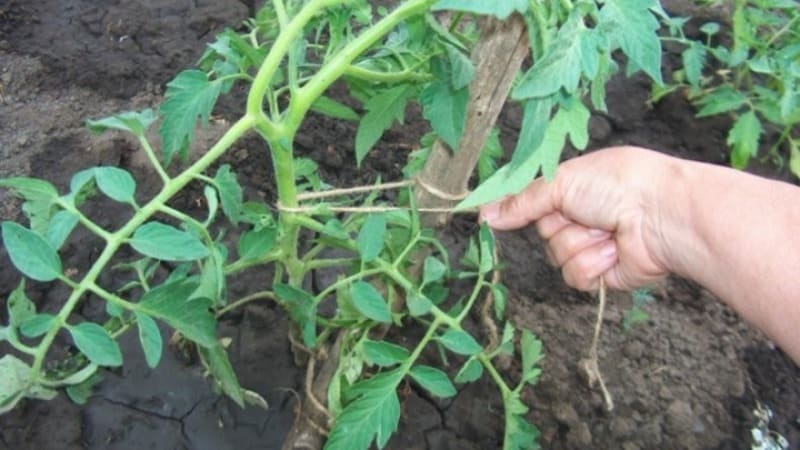
To prevent the fruits from being small, the plant should be formed into 1 or 2 stems. The shaping of the bush also affects the quantitative indicator of fruiting: if the side shoots are not removed in a timely manner, the harvest is significantly less. In addition, an excessive number of stepsons leads to thickening of plants, which negatively affects further development.
The shoots are removed before they reach 5 cm, otherwise the procedure will not be painless for the tomatoes. Plants are planted in the morning so that by evening all the wounds have time to heal. After removing the shoots, the cut sites are treated with a weak solution of potassium permanganate or sprinkled with ash.
Despite the fact that the type is determinate, seedlings without additional support will not withstand the weight of ripe vegetables. During transplantation, wooden pegs or metal rods are installed next to each bush, to which the stem is immediately attached. Fruitful branches are tied to a support as they develop.
Diseases and pests
For tomatoes, the most dangerous attacks are whitefly and spider mites. Spider mites live mainly in greenhouses, since the most favorable conditions for them in terms of temperature and humidity are created there. To eliminate it, it is enough to ventilate closed structures every day. Fresh air destroys the pest’s usual habitat.
Pheromone traps installed near the seedlings help against whiteflies. She is also repelled by plants with strong odors, for example: calendula, onions and garlic. Therefore, they are planted next to tomato beds. When there is a large concentration of parasitic insects, use the insecticide “Confidor”, dissolving 1 ml in 10 liters of water. This drug is also used for preventive purposes.
The crop has strong immunity to nightshade diseases, so preventive measures are quite enough to keep the seedlings healthy throughout the season.
After transplantation, young plants are sprayed with a weak solution of potassium permanganate. Further actions are limited to moderate watering, systematic loosening and weed removal.
To prevent fungal diseases, fungicidal agents such as Fitosporin and copper sulfate are used. Any copper-containing preparations are also suitable for treating plants.
According to the rules of crop rotation, it is not recommended to plant tomatoes next to potatoes. Such proximity leads to negative consequences. These two crops belong to the same nightshade family and are affected by the same diseases and pests.
Read also:
Why do spider mites appear on cucumbers?
Growing in open ground and greenhouse
In open ground, plant height is significantly lower than that of greenhouse seedlings. Plants look more powerful and compact.
The culture is recommended for cultivation in protected structures, as it was bred specifically for harsh climates. Nevertheless, residents of the southern regions successfully grow the variety in open beds. Moreover, the seeds are planted directly into the ground, bypassing the seedling period.
Annual change of the top layer of soil in greenhouses reduces the risk of various infections. In addition, the new soil is more saturated with useful substances necessary for full development.
When transplanting into open ground, more distance is left between seedlings than in a greenhouse. 2-3 plants are placed per 1 m2 if they are formed into 2 stems. Otherwise, due to the denseness of the plantings, the seedlings will not receive the required amount of light and ventilation. When a bush is formed, 3-4 seedlings are placed in 1 stem per 1 m2.
Harvesting and application

Tomatoes are not allowed to overripe by harvesting on time. Ripe vegetables can be stored for a long time in a cool, dry place. Thanks to their durable skin and dense pulp, tomatoes do not deform or crack during long-term transportation.
The excellent taste allows vegetables to be used universally in cooking. They make excellent summer salads, first and vegetable courses, various snacks and cuts. The obvious sourness does not disappear when preparing freshly squeezed and canned juices, which adds a piquant taste to tomato products. Among winter preparations, vegetables are suitable for marinades, pickles, ketchups, adjika, lecho, sauces and pastes.
Advantages and disadvantages
Culture has a number of positive qualities, thanks to which it has received universal recognition:
- ability to adapt to harsh climates;
- early ripening;
- unpretentious care;
- resistance to dangerous diseases;
- high yield;
- excellent taste;
- large-fruited species;
- long-term storage;
- universal use;
- safety of fruits during long-term transportation.
The disadvantages include the obligatory garter, the formation of a bush and the regular removal of stepsons.
Farmer reviews
Favorable reviews of the Pride of Siberia tomato are another big plus. Many gardeners choose varieties for planting based on the characteristics of the crop and reviews from experienced gardeners.
Kristina, Novosibirsk: “The tomato is excellent for growing in the difficult Siberian climate. The fruits are really large, juicy and very tasty. The seedlings do not get sick and are not damaged by pests. I like this species for its sustainability, taste and easy care. I’ve been planting for several years now and I’m happy with everything.”
Anatoly, Krasnodar region: “The weather here is excellent, I sow the seeds directly into the garden bed. Everyone comes up. The seedlings are strong, up to 110 cm high. I form them into 1 and 2 stems. The yield is excellent, 4.5 kg from each bush. This is a good indicator, so I’ve been growing it for three years now and will plant it again.”
Conclusion
Tomato Pride of Siberia is a leader among large-fruited varieties in difficult climates. It is resistant to many diseases, easy to care for and produces a rich harvest. Thanks to the harmonious combination of sweetness and sourness in taste, the universal use of ripe fruits makes the variety indispensable in cooking.For many gardeners in various regions of the country, the crop has become unique among other tomato varieties.